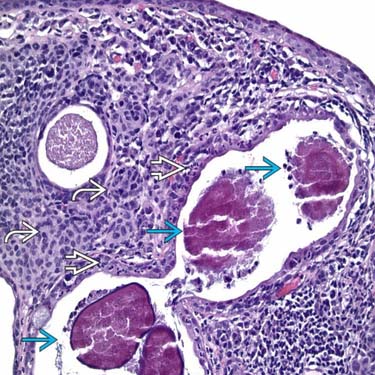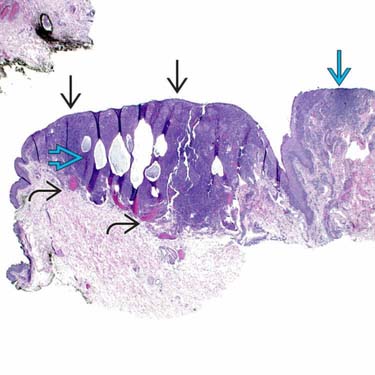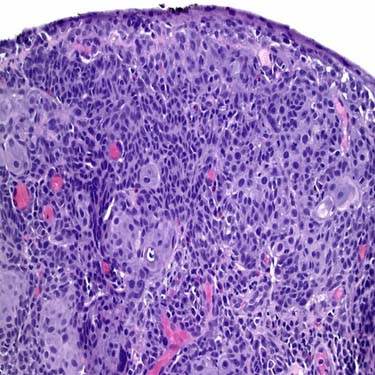Conjunctival melanocytic nevi (50%) can exhibit numerous epithelial-lined cysts  located within the lesion, as seen here under scanning magnification. This is a useful finding, supporting benignancy. Note the lymphohistiocytic infiltrate
located within the lesion, as seen here under scanning magnification. This is a useful finding, supporting benignancy. Note the lymphohistiocytic infiltrate  hugging the lesion.
hugging the lesion.

Higher power magnification shows the cysts to contain sulfur granules
 and invoke a neutrophilic response
and invoke a neutrophilic response  . The nested nevomelanocytes
. The nested nevomelanocytes  , surrounding the infected cysts, are devoid any cytological atypia.
, surrounding the infected cysts, are devoid any cytological atypia.
At this scanning magnification, a hypercellular proliferation appears to occupy the subepithelium
 underneath the conjunctival epithelium
underneath the conjunctival epithelium  . There is intralesional cystic degeneration
. There is intralesional cystic degeneration  . There is a focus of intense lymphohistiocytic infiltrate
. There is a focus of intense lymphohistiocytic infiltrate  commonly seen in these lesions.
commonly seen in these lesions.
A higher magnification is shown from the same lesion. The subepithelial component does not appear to decrease in the nuclear:cytoplasmic ratio. This paradoxical maturation is an expected feature.
MICROSCOPIC
Histologic Features
• Anatomic classification (similar to skin)
 Junctional: Nested but sometimes also lentiginous proliferations of type A or type B cells confined to epithelium
Junctional: Nested but sometimes also lentiginous proliferations of type A or type B cells confined to epithelium




 Junctional: Nested but sometimes also lentiginous proliferations of type A or type B cells confined to epithelium
Junctional: Nested but sometimes also lentiginous proliferations of type A or type B cells confined to epitheliumStay updated, free articles. Join our Telegram channel

Full access? Get Clinical Tree








